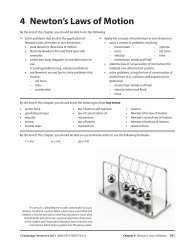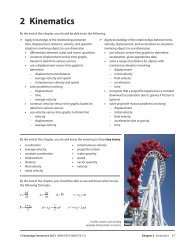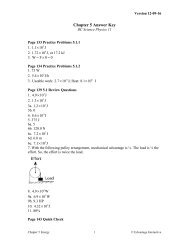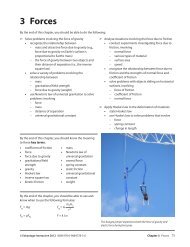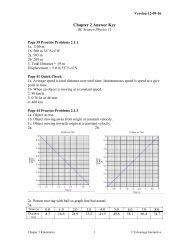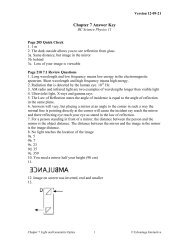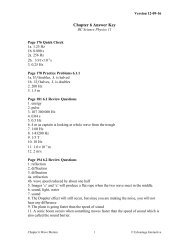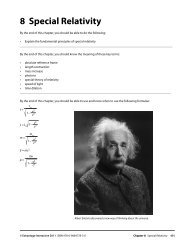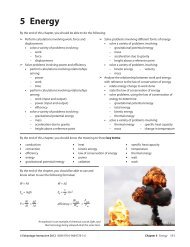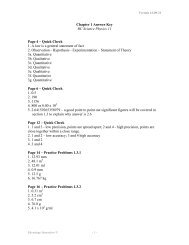1 Skills, Methods, and the Nature of Physics - BC Science Physics 11
1 Skills, Methods, and the Nature of Physics - BC Science Physics 11
1 Skills, Methods, and the Nature of Physics - BC Science Physics 11
You also want an ePaper? Increase the reach of your titles
YUMPU automatically turns print PDFs into web optimized ePapers that Google loves.
Graphing<br />
���<br />
���<br />
���<br />
���<br />
���<br />
�������<br />
���<br />
�<br />
��������<br />
In Figure 1.4.3, a variable y is plotted against a variable x. Variable y is <strong>the</strong> dependent<br />
variable <strong>and</strong> variable x is <strong>the</strong> independent variable. In this particular situation, <strong>the</strong> graph<br />
is a straight line. (You might say that variable y is a linear function <strong>of</strong> <strong>the</strong> variable x.)<br />
Figure 1.4.3 In a straight line graph like this one, <strong>the</strong> variable y is a linear function <strong>of</strong><br />
<strong>the</strong> variable x<br />
The slope <strong>of</strong> <strong>the</strong> graph is given <strong>the</strong><br />
symbol m, where m = rise<br />
run .<br />
To find <strong>the</strong> value <strong>of</strong> <strong>the</strong> slope, <strong>the</strong> two points with coordinates (0,b) <strong>and</strong> (x, y) will be<br />
used. The value <strong>of</strong> y where <strong>the</strong> graph intercepts <strong>the</strong> y-axis is called <strong>the</strong> y-intercept, <strong>and</strong> it<br />
is given <strong>the</strong> symbol b.<br />
�<br />
�����<br />
��������������������������������<br />
��������������� ��������������<br />
�����������<br />
�<br />
� �� ���� ���� ���� ���� ���� ���� ���� ���� ���� ����<br />
Figure 1.4.4 The slope <strong>of</strong> a line can be calculated using just two<br />
points.<br />
�������������<br />
����� ����� �<br />
�<br />
Since m = rise<br />
run<br />
= (y – b)<br />
(x – 0) ,<br />
Therefore, mx = y – b, or<br />
y = mx + b<br />
This is a general equation for any straight line. The<br />
slope <strong>of</strong> <strong>the</strong> line is m <strong>and</strong> <strong>the</strong> y-intercept is b.<br />
To write an equation for any straight-line graph,<br />
you need only determine <strong>the</strong> value <strong>of</strong> <strong>the</strong> y-intercept by<br />
inspection <strong>and</strong> <strong>the</strong> slope by calculation. You can <strong>the</strong>n<br />
substitute <strong>the</strong>se values into <strong>the</strong> general equation.<br />
For <strong>the</strong> linear graph in Figure 1.4.4, <strong>the</strong> y-intercept,<br />
by inspection, is 1.4. (b = 1.4) The slope is calculated using<br />
<strong>the</strong> two points with coordinates (0, 1.4) <strong>and</strong> (10.0, 4.4).<br />
© Edvantage Interactive 2012 ISBN 978-0-9864778-3-6 Chapter 1 <strong>Skills</strong>, <strong>Methods</strong>, <strong>and</strong> <strong>the</strong> <strong>Nature</strong> <strong>of</strong> <strong>Physics</strong> 27<br />
m =<br />
(4.4 – 1.4)<br />
(10.0 – 0)<br />
3.0<br />
= = 0.30<br />
10.0<br />
The equation for this straight line is <strong>the</strong>refore: y = 0.30 x + 1.4<br />
In <strong>the</strong>se examples, <strong>the</strong> units <strong>of</strong> measure <strong>of</strong> <strong>the</strong> variables have not been included,<br />
in order to simplify <strong>the</strong> explanation. In experiments, <strong>the</strong> observations you make are<br />
frequently summarized in graphical form. When graphing experimental data, always<br />
include <strong>the</strong> measuring units <strong>and</strong> <strong>the</strong> specific symbols <strong>of</strong> <strong>the</strong> variables being graphed.<br />
������



